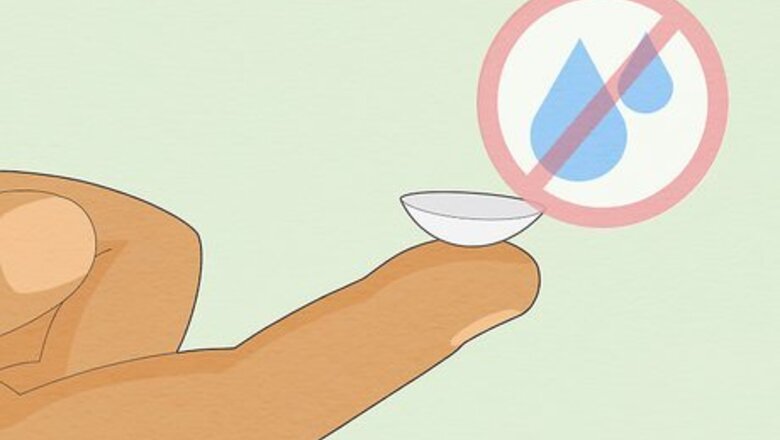
views
- Contact lenses and water don’t mix. Water can warp the shape of your lenses and has microorganisms that can lead to eye infection.
- Take out your contacts before bathing or swimming. If you have to keep them in, soak them in disinfecting contact solution for 24 hours afterward.
- If you’re out of solution, throw your lenses out instead of storing them. If you must keep them, use store-bought saline (not homemade saline).
Can I store contacts in water?
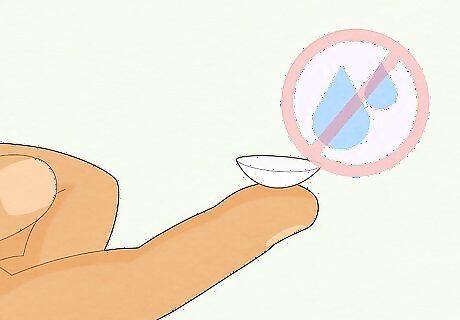
No, don't expose or store contact lenses in water. Tap water, pool water, and lake or ocean water contain microorganisms that can potentially lead to serious eye infection. One of the most common is Acanthamoeba, which can infect your cornea (the clear outer layer of your eye where your contacts sit). Water can make your contacts swell or warp, causing them to stick to your eyes and scratch your cornea. This makes it easier for bacteria to enter your eye.
Swimming in Contacts
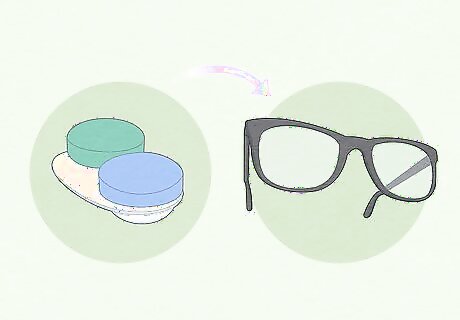
Remove your lenses before swimming and store them in solution. Always try to take out your daily, monthly, or biweekly lenses before swimming in pools, hot tubs, lakes, or oceans, as well as using the shower, bathtub, or a sauna. If storing them isn’t an option, swim with goggles on and soak your monthly or biweekly lenses in contact solution for 24 hours to disinfect them (throw away daily lenses). Alternate between 2 pairs of lenses or between lenses and glasses so you can see while the water-exposed pair disinfects. If you don’t have goggles, do your best to avoid getting splashed in the face and eyes while you’re in the pool or tub. Any amount of water in your eyes can transfer bacteria to your contact lenses, even if it’s just a quick shower or splash to the face.
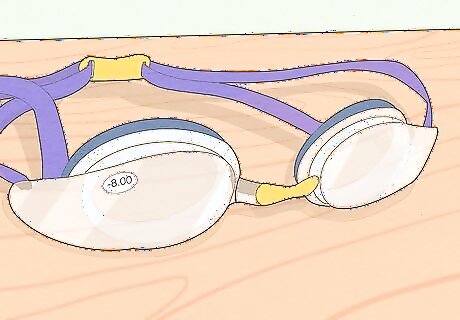
Use prescription goggles or consider LASIK eye surgery. If you're a frequent swimmer, the best alternative to wearing lenses is prescription goggles. Shop from performance brands rather than leisure brands—it’s easier to find a pair with a good fit against your face. If you can't find a pair with your exact prescription, choose the closest option, which will still let you see clearly below and around you while swimming. Consider LASIK if contacts or glasses are a nuisance. Consult a reputable center that checks your general eye health in addition to LASIK eligibility. Alternatively, switch to daily contact lenses and continue wearing goggles. Throw away the potentially infected lenses after your swimming session.
Contact Solution Alternatives
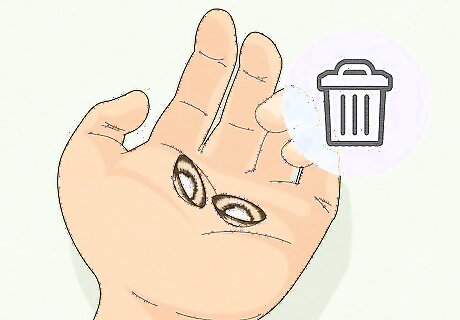
Throw away your contact lenses and put in a new pair. Toss your current pair if you realize you’re out of solution and can’t buy any right away—this is the most effective way to guarantee you won’t accidentally infect your lenses by using other substances. Ignore rumors that distilled water or saliva work in a pinch, since they can still contain microorganisms (especially your spit!). Remember, it’s way less inconvenient to throw out a good pair of lenses and buy more solution than it is to deal with an eye infection.
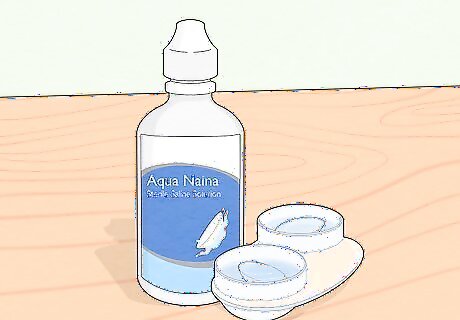
Try store-bought saline, even if it’s not meant for contact lenses. Use a sterile saline wound wash or nasal spray (0.9%) if absolutely necessary, but try not to do this for more than 1 day or night. It’s safer than water because it’s sterile and will keep your lenses from drying out. However, it won’t clean them or remove mineral deposits like an enzymatic contact lens solution. Saline for contacts is not the same as contact solution. Contact solution cleans and disinfects while saline is just pH-balanced saltwater used for rinsing. Non-contact lens saline is not as gentle on your eyes and may cause discomfort. Use this as a last resort if you cannot throw out your lenses. Avoid using homemade saline solution to store or rinse your contact lenses. The risk of infection is too great.
Storing Contacts Safely
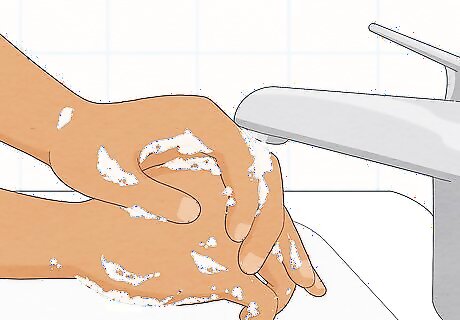
Wash your hands with hot water and antibacterial soap. As a rule, always aim to wash your hands thoroughly before handling your contact lenses. Dry your hands well with a clean, lint-free cloth to keep water droplets and towel fibers off your fingertips. Dirty hands are an easy way to transfer bacteria to your eyes, even if they’re not wet with tap water.
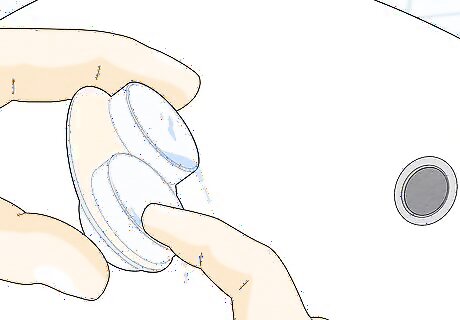
Rub the inside of your contact case with contact solution to clean it. If there’s old solution sitting in the case, dump it out. Squirt a few drops of fresh solution into each well and use your finger to rinse out the case. Dry out the wells with a clean tissue. After the case is clean, fill each well with solution. Always use fresh solution instead of “topping off” old solution to avoid bacteria buildup in your case. Whenever you get a new bottle of solution, throw away your old case and get a new one (most bottles of solution come with an included case).
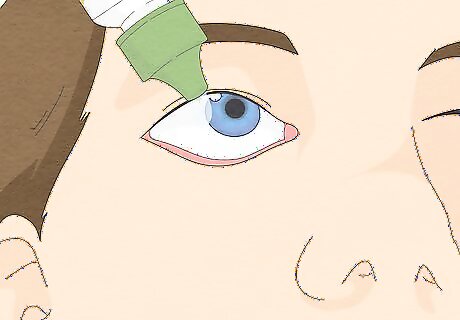
Apply eye drops to each eye if your contacts feel dry or stuck. Tilt your head back and hold your eyelids open with your non-dominant hand. With your other hand, squeeze 1-2 drops into your eye. Blink a few times to circulate the eye drops and blot any liquid that runs down your face with a tissue. Repeat in your other eye. Use saline or moistening eye drops. Both will lubricate your contact lens and make it easier to remove.

Hold your eyelid open and remove one contact lens at a time. Use the middle finger on your non-dominant hand to pull your upper eyelid up and your middle finger on your dominant hand to hold your lower eyelid down. Then, use your dominant pointer finger and thumb to gently pinch and grab the contact and pull it away from your eye. Look straight ahead into a mirror or look slightly upward—whichever feels easier. Try to grab the lower half or lower third of the lens. The lens will bend and pull away from your eye a bit easier than if you grab at the exact middle. Start with the same eye each time you remove your lenses to avoid mixing them up (it doesn’t matter which you do first as long as you’re consistent).
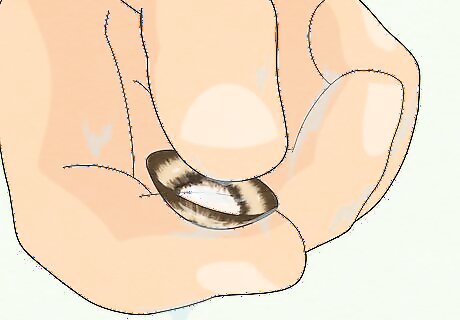
Rub the lens between your pointer finger and thumb to clean it. Wet your fingers with contact solution and gently rub the lens for a few seconds, making sure to clean both sides. This gets rid of mineral deposits and any loose fibers, dust, or dirt that might be on the lens. Alternatively, squirt some solution into the palm of your hand and rub both sides of the lens in it with your pointer finger. Soaking your contacts overnight without rubbing them first is not as effective for disinfecting and can shorten the life of your lenses.
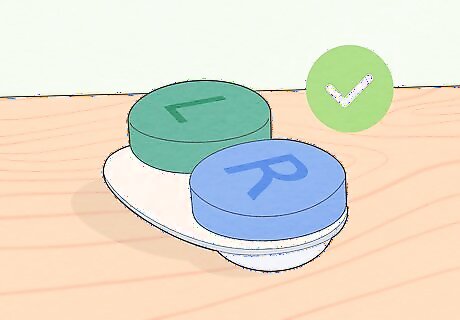
Put the lens in your contact case. Make sure to put the left lens in the left well or the right lens in the right well. Most case wells are marked “L” and “R” to help you keep track of your lenses. Securely twist or snap the well lid shut. Do not store your lenses in anything besides a designated contact lens case with contact solution.
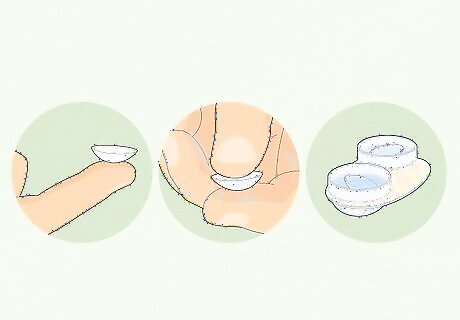
Remove, rub, and store your other contact lens. Once your first lens is securely stored, take your other lens out. Rub it between your fingers or in your palm with solution to remove mineral deposits, then place it in the left or right well of your case, depending on which eye you did first. Most solution brands recommend soaking your lenses for at least 4-8 hours before putting them back in. Check the instructions on your bottle for specifics.




















Comments
0 comment